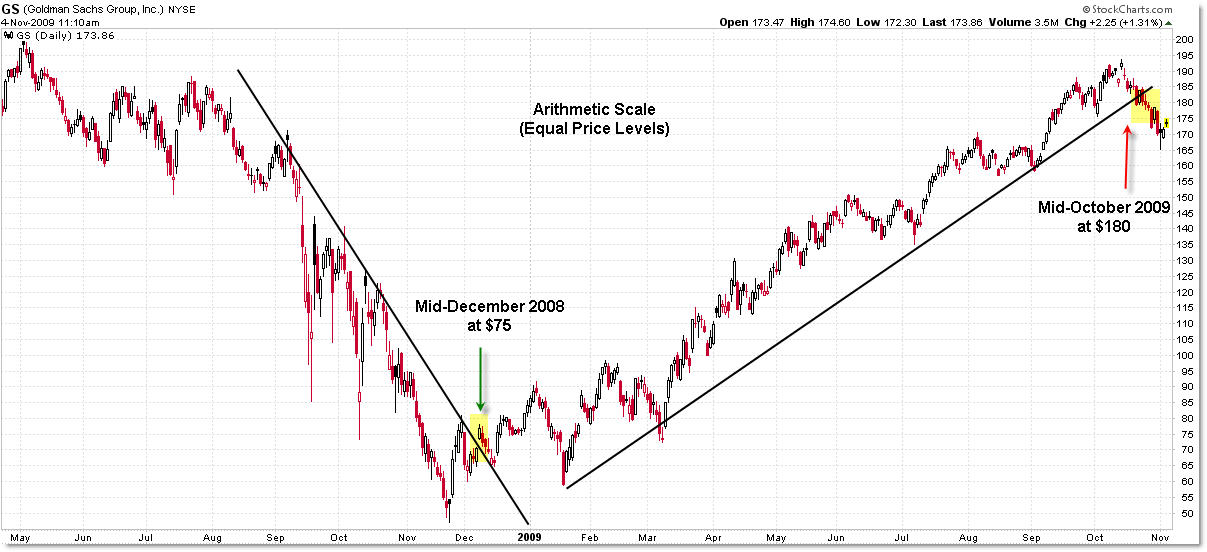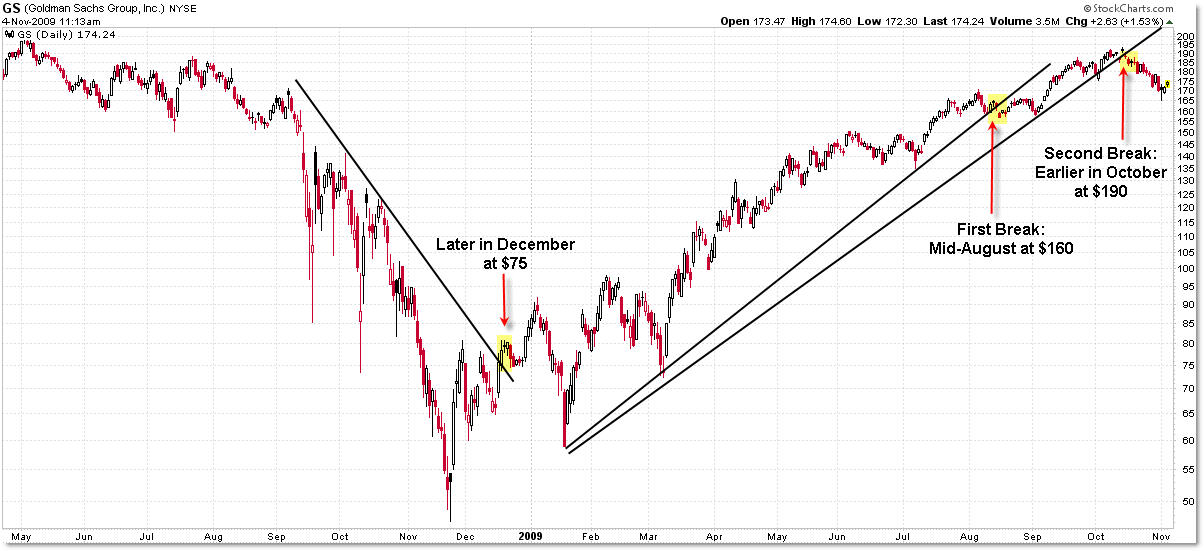The Difference Between Logarithmic and Arithmetic Trendlines
If you’re ever been puzzled whether or not to use a logarithmic or arithmetic chart and how to interpret trendlines, you’re not alone. Let’s take a recent look at Goldman Sachs (GS) and compare the different up and down trendlines on both scales to note the key differences and insights from both.
First, let’s take a look at the regular or arithmetic scale, which keeps price changes (dollars) constant in the scaling:
Using a simple trendline moving down into the 2008 lows, we see that price broke upwards from the descending trendline on December 8th, 2008 with a gap through the line. This occurred at $74 per share.
As price rose through 2009, we see another simple trendline that connected (roughly) the five swing lows that was broken to the downside officially on October 28 as price broke beneath $180 per share… though it was marginally broken slightly earlier.
What might a logarithmic view of this same time period have showed us?
Next, let’s compare the logarithmic chart, which places more importance on percentage changes (keeping percent moves constant):
The benefit to logarithmic charts is that we are comparing percentage moves instead of pure price moves. Thus, a $1 move on a $1 stock would be a 100% move as compared with a 1% move as a stock moved from $100 to $101.
Logarithmic charts are often used over longer time periods when large price swings or percentage moves in price have occurred.
The trade-off is that we compress the upper range in price and expand the lower range, highlighting (or exaggerating) smaller dollar moves.
How does this then translate into trendline analysis?
Goldman Sachs broke the descending trendline slightly later with the second upside gap that occurred also at the $80 level on December 17th – that’s 9 days later than the arithmetic scale.
What about the rising trendline?
We can actually draw a better trendline – labeled the “first” trendline, which price broke in Mid-August at the $160 per share level. This did not forecast a reversal, and a second trendline connected the September and October lows to the prior 2009 lows.
This trendline was broken as price was at the $190 level on or around October 16th – roughly 12 days prior to the arithmetic trendline break.
General Principle
This example of Goldman Sachs (GS) gives us a general principle to follow:
Downwards Sloping Logarithmic Trendlines are broken LATER than similar trendlines on Arithmetic Charts;
Upwards Sloping Logarithmic Trendlines are broken SOONER than similar trendlines on Arithmetic Charts.
Sometimes these ‘sooner’ trendline breaks result in false signals… or just signals that are well in advance of their arithmetic trendline counterparts.
Because this is a daily chart, we’ll see only slight changes between the two charts, but this effect would be magnified over longer periods – making the difference between signals in months instead of days or weeks.
Both have their uses and neither is superior to the other in price analysis.
However, this is a distinction you need to know when applying long-term trendline price analysis.
Corey Rosenbloom, CMT
Afraid to Trade.com
Follow Corey on Twitter: http://twitter.com/afraidtotrade



Thanks, Corey. Always wondered about this. So if we want a heads up on trend changes, should be use a log scale?
Hey Terry!
Not necessarily – or at least not if you're trying to anticipate an upside breakout from a downtrend – the log-scale may actually give a lagging signal.
Or, in the case above, if you started getting short at the first log trendline break in Goldman, you would have suffered losses as the stock kept rising.
But in general, yes, log trendline breaks will give an advance warning that an uptrend might be nearing an end.
Good writeup. I have being following your blog and its very informative to track US Markets.
Keep up the good work.
http://www.TradersPlace.in
Q? When applying fib tools (grids, fans, arcs) does it matter whether you use a arithmetic or logarithmic setting?
Bob
Thanks Corey. I did not expect a whole post on the issue but the answer, as alway, is informative and certainly appreciated. Happy trading!
Hi,
Stock market India is volatile and all those who speculate in market are loosing everyday. Please remember stock market is not for speculation purpose. If one feel investing in stock market is gamble then its better to think again.
One should always note that if they want to invest money they should do proper research be it fundamental research or technical research. Just think how come you can invest
your money without any convincing reason for the same?
Indian stock market is one of the most happening and emerging market. Major Indian stock exchanges are BSE and NSE and both are of world class standards.
So grab good stocks and invest that’s the bottom line.
We hope to see you in major profits.
Regards
SHARETIPSINFO TEAM
If you are trading in NSE, BSE, MCX and in NCDEX then let sharegyan give you all stock trading gyan
he shorts blame the longs but I think they took the market up. BusinessCarsView.com
Thanks for your marvelous posting! I truly enjoyed reading it, you
may be a great author. I will make sure to bookmark your blog
and will often come back sometime soon. I want to encourage you to ultimately continue your great posts, have
a nice day!